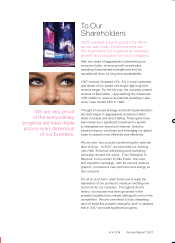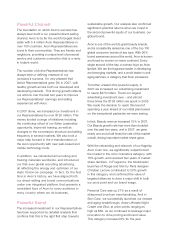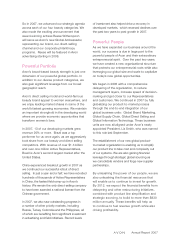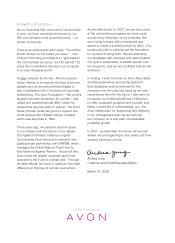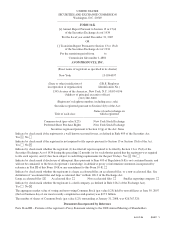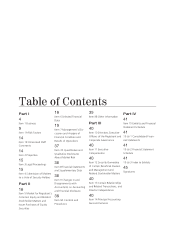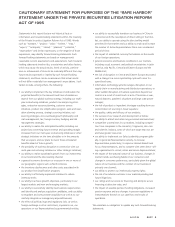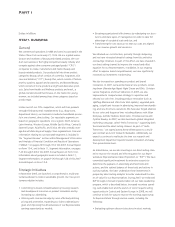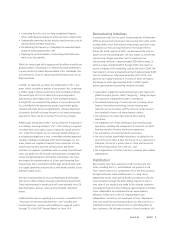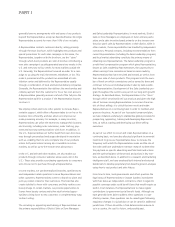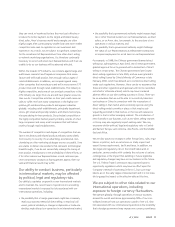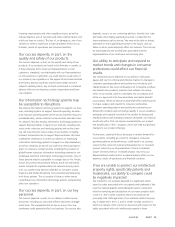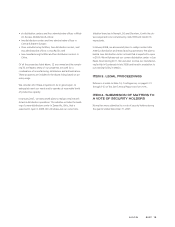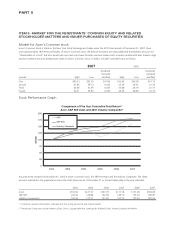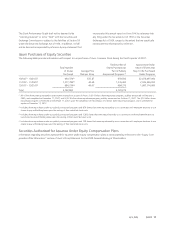Avon 2007 Annual Report Download - page 13
Download and view the complete annual report
Please find page 13 of the 2007 Avon annual report below. You can navigate through the pages in the report by either clicking on the pages listed below, or by using the keyword search tool below to find specific information within the annual report.contributions could be so substantial in the context of the vol-
ume and profitability of our business in that country that we
would consider discontinuing operations in that country.
Promotion and Marketing
Sales promotion and sales development activities are directed at
assisting Representatives, through sales aids such as brochures,
product samples and demonstration products. In order to sup-
port the efforts of Representatives to reach new customers, spe-
cially designed sales aids, promotional pieces, customer flyers,
television and print advertising are used. In addition, we seek to
motivate our Representatives through the use of special incentive
programs that reward superior sales performance. Avon has
allocated significant investment to understand the financial
return of such field incentives. Periodic sales meetings with
Representatives are conducted by the District Sales Managers or
Zone Managers. The meetings are designed to keep Representa-
tives abreast of product line changes, explain sales techniques
and provide recognition for sales performance.
A number of merchandising techniques are used, including the
introduction of new products, the use of combination offers, the
use of trial sizes and samples, and the promotion of products
packaged as gift items. In general, for each sales campaign, a dis-
tinctive brochure is published, in which new products are
introduced and selected items are offered as special promotions or
are given particular prominence in the brochure. A key current
priority for our merchandising is to expand the use of pricing and
promotional models to enable a deeper, fact-based understanding
of the role and impact of pricing within our product portfolio.
As previously discussed, we significantly increased spending on
advertising during 2007 and 2006. During 2007, we launched
“Hello Tomorrow,” our first global, integrated marketing cam-
paign, supporting both the brands in our core beauty product
lines and the direct-selling channel. We have increased our
investments in upgrading the quality and size of our brochure in
many markets. We also increased the number of promotional
treatments such as cut out and oversized folded pages. We
expect this to be an ongoing investment to strengthen our
beauty image worldwide and drive sales positively.
From time to time, various regulations or laws have been pro-
posed or adopted that would, in general, restrict the frequency,
duration or volume of sales resulting from new product
introductions, special promotions or other special price offers.
We expect our pricing flexibility and broad product lines to miti-
gate the effect of these regulations.
Competitive Conditions
We face competition from various products and product lines
both domestically and internationally. The beauty and
beauty-related products industry is highly competitive and the
number of competitors and degree of competition that we face
in this industry varies widely from country to country. World-
wide, we compete against products sold directly to consumers
by other direct-selling and direct-sales companies and through
the Internet, and against products sold through the mass market
and prestige retail channels.
Specifically, due to the nature of the direct-selling channel, Avon
competes on a regional, often country-by-country basis, with its
direct-selling competitors. Unlike most other beauty companies,
we compete within a distinct business model where providing a
compelling earnings opportunity for our Representatives is as
critical as developing and marketing new and innovative prod-
ucts. As a result, in contrast to a typical CPG company which
operates within a broad-based consumer pool, we must first
compete for a limited pool of Representatives before we reach
the ultimate consumer.
Within the broader CPG industry, we principally compete against
large and well-known cosmetics and fragrances companies that
manufacture and sell broad product lines through various types
of retail establishments. In addition, we compete against many
other companies that manufacture and sell more narrow CFT
product lines sold through retail establishments.
We also have many competitors in the gift and decorative prod-
ucts and apparel industries globally, including retail establish-
ments, principally department stores, gift shops and specialty
retailers, and direct-mail companies specializing in these
products.
Our principal competition in the fashion jewelry industry consists
of a few large companies and many small companies that sell
fashion jewelry through retail establishments.
We believe that the personalized customer service offered by our
Representatives; the amount and type of field incentives we offer
our Representatives on a market-by-market basis; the high qual-
ity, attractive designs and prices of our products; the high level
of new and innovative products; our easily recognized brand
name and our guarantee of satisfaction are significant factors in
establishing and maintaining our competitive position.
International Operations
Our international operations are conducted primarily through
subsidiaries in 65 countries and territories outside of the U.S. In
addition to these 65 countries and territories, our products are
distributed in 48 other countries and territories through
distributorships.
Our international operations are subject to risks inherent in
conducting business abroad, including, but not limited to, the
A V O N 2007 7


